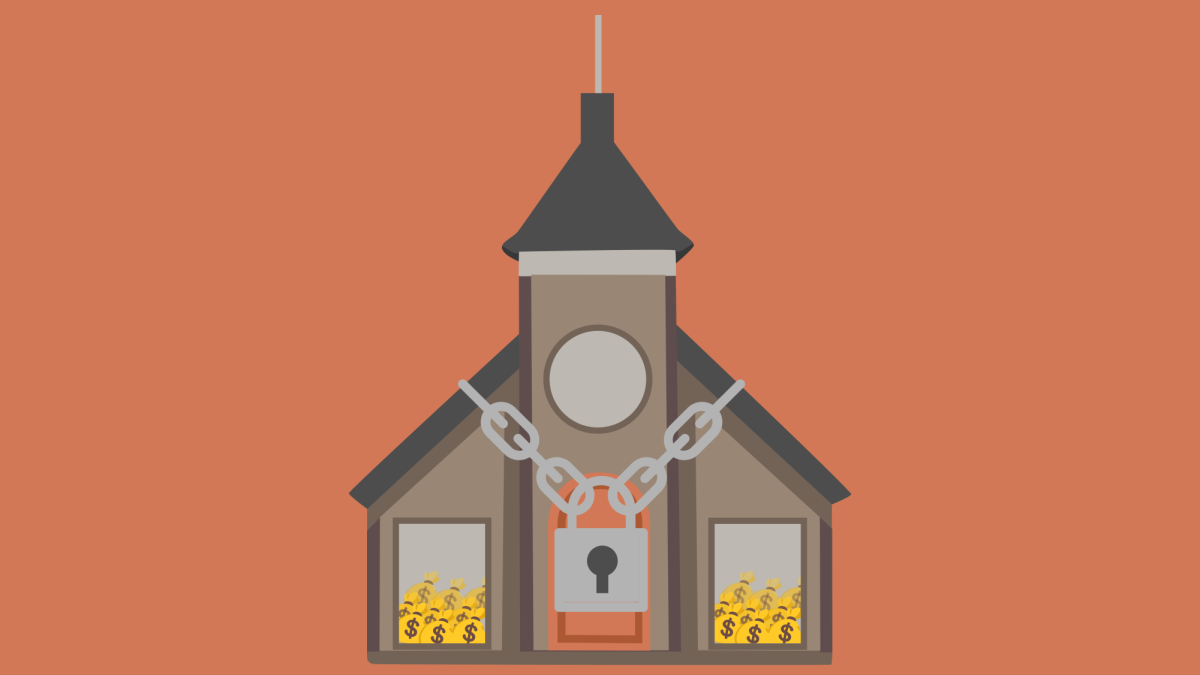Jarvis: The LDS Church is a Big Business
(Design by Claire Peterson | The Daily Utah Chronicle)
July 7, 2023
Members of The Church of Jesus Christ of Latter-day Saints pay 10% of their monthly income to the church as tithing. I grew up in the religion, so as a child I gave 10% of what little money I had to the church. This means if I — at eight years old — did an odd job for a dollar, I’d set aside a dime. I did not question this. It was just what we did. In my teens, after I’d distanced myself from the church and stopped giving it money, I understood that it was very wealthy. Now, the general public is aware that the church has more than about $100 billion.
The church is dishonest with its money, violating tax laws and coercing its members into paying significant portions of their income. Rather than hoarding this money, it should help people directly like it teaches its members to do.
Buy Your Way to Heaven
Tithing isn’t simply a donation, nor is it optional for church members. Church leaders hold annual tithing declaration meetings to check that members are paying. My family attended these meetings together, where they asked us one by one if we were full-tithe payers.
I remember other members and church leaders telling stories to emphasize the importance of tithing. These stories involved wallets lost and found, or envelopes full of cash appearing on doorsteps — blessings from God in return for tithing payment. The church also teaches that paying tithing can break cycles of poverty and that you should pay tithing before paying other bills or spending money.
It’s not just anecdotal, it’s also doctrinal. Eternal salvation as a Mormon depends on entering the temple, something you can’t do if you don’t pay tithing. This salvation is central to members of the religion, which teaches that making it into the highest level of heaven is the ultimate goal. Still, knowing that tithes will be used for noble causes would put tithe-paying members at ease.
The Church’s Lack of Transparency
Church officials make it seem like paying the church is like giving to charity, and the organization is, like a charity, tax-exempt. The money in the church’s $100 billion fund was intended for charity but was stockpiled instead. It doesn’t need members’ money, but leaders continue to demand payment while hiding where their money really goes.
Non-profits with tax-exempt status are required to make their records available to the public. The church doesn’t just neglect to disclose its financial records, it “went to great lengths to avoid” doing so, hiding $32 billion in shell companies, according to the SEC. For this, it paid a $5 million penalty — only 0.005% of its rainy-day fund.
One of the church’s main teachings is to help those in poverty. Unlike in other spending areas, the church needs no push to announce how much it spends on charitable giving. In 2022, they claimed to spend $1 billion helping those in need. But for a church receiving billions every year, spending $1 billion on charity isn’t impressive.
Though the church has more money than the Bill and Melinda Gates Foundation, the world’s largest charitable organization, the Foundation donates about seven times more yearly than the church. The amount of humanitarian aid and welfare the church provides is a minuscule percentage of what it could afford to spend, and it often comes with strings attached. People seeking welfare from the church must meet with missionaries and attend church services, sometimes even getting baptized to get help. This means they often must pay tithing to get financial assistance.
According to the Widow’s Mite Report on LDS charities, only one-tenth of welfare and humanitarian aid the church provides is given without regard to religious affiliation. Most of its welfare assistance takes place within the church. The internal welfare record includes things like missionary proselytizing hours, something most people would not consider to be service. Church leaders urge all male members to go on mission trips, but make them pay for it themselves. Internal welfare also includes church facility volunteering — despite their regular payments, members are expected to clean their own church buildings.
The report, updated in 2022, also notes that the church measures its charitable giving with unclear metrics. This leads to the church double-counting some inputs, exaggerating impact claims and misleading readers about how much it really spends.
Greater Causes
The church spends tens of millions of dollars on buildings such as temples. Church officials plan to build 15 more temples in the next few years, a pointless endeavor as the church’s growth rates are declining. The church also owns office towers, skyscrapers and shopping malls.
As the church was spending at least $1.5 billion to build the City Creek Center in 2012, an increasing number of people were unsheltered in Utah, where the church’s headquarters are. Helping these people would have been a much better use of this money.
We should not look past what the church is doing right. It donated water to the Great Salt Lake this year and money for COVID vaccinations in 2021. While we can be grateful for these donations, we must expect the church to do more — a lot more.
The church should focus on spending its money to help members of the community, with no strings attached. Anyone should be able to turn to the church for welfare without being pressured to join the religion. Members of the church should also be able to receive help when they need it, especially after all the money they’ve donated.
The LDS church has the power to help many people, but it does only the bare minimum, dodging taxes as its fund keeps growing.










Hmm • Nov 17, 2023 at 9:30 am
Caroline Jarvis, thank you for sharing your observations of Church resources use for charity.
Please, in the spirit of openness would you share the details of your income, savings, net worth, and most importantly your personal financial contributions to charity?
Please, how do you fund/insure your healthcare?
Do you have the courage to hold yourself to the same measure that you hold others? Let alone the courage to post this comment?
Hmm
Jackye • Nov 26, 2023 at 12:05 pm
Wow! Keep your eyes shut tight and keep on trying to convince yourself that the LDS Church is honest.
A note: The Church donated money for the C’vid vax in self-interest. They own more than $400,000,000.00 US in Merck stocks.
Thomas • Oct 13, 2023 at 8:37 am
I like how in social media people always say the “grew up in the church” or they are an ex-Mormon or my mother goes to church like it gives them credibility to speak about the topic. What they fail to mention is they never practiced any tenet of the religion or delved into the teachings of said church; if they did work and gain knowledge then they would probably still be active members. People are lazy. Since you left how many days a week do you read the Bible?
On another point I would expect Christ’s church to be blessed and its investments to grow to be able to continue his mission on earth.
Steve • Jul 11, 2023 at 3:37 pm
C’mon. Every member of the Church knows tithing is voluntary. It is only if you believe in the tenets of the Church that you would follow the admonition of Jesus Christ to donate to His mission. Just like if you believe in Bill and Melinda — you can donate to the foundation.
Moreover, just how did Jesus Christ value money?
Mark 12
41 And Jesus sat over against the treasury, and beheld how the people cast money into the treasury: and many that were rich cast in much.
42 And there came a certain a poor widow, and she threw in two mites, which make a farthing.
43 And he called unto him his disciples, and saith unto them, Verily I say unto you, That this poor widow hath cast more in, than all they which have cast into the treasury:
44 For all they did cast in of their abundance; but she of her want did cast in all that she had, even all her living.
Money is only a tool. It will help you to accomplish your mission, but it will not replace you as the driver. And the Church is a good driver. It follows the same savings principles it teaches its members. It educates to methodically safeguard through wise financial management, and build prudent reserves for the future. I promise. If you follow this sound advice, you will find yourself in a remarkably favorable position in the future.
All Church funds exist for no other reason than to support the Church’s divinely appointed mission.
For perspective, and since you find percentages useful, the Church’s $100 billion is 0.0204 of the annual tax revenue the IRS receives EVERY year.
Cheers!
Alex • Jul 9, 2023 at 5:53 am
First editor is lying when says church coerce so.we pay tithing. Not true. They dont force you. If you leave church for a while and stop paying tithing, if you come back the church doesnt ask you to pay all the tithing you didnt.
Second, 100 billing looks a lot but the church has a big spending. Count temple construction but also its maintenance. Also meeting houses, they also get refurbish completely all over the world plus meeting houses maintenance costs. Members just clean. Add to that all the salaries, missionary costs, and all other departments. So for me 100 bill is not that much.
The problem here is that companies leverage things with credit. Church doesnt do that. So, what can church do if something happens and it doesn have incomes without going to banks? Have savings and that is why.
Xiangyao Tang • Jul 8, 2023 at 7:29 pm
I was definitely shocked to learn that LDS members have to pay tithe when I first came to Utah a few years ago. Can’t believe mandatory tithing is still a thing in the 21st century 🙁
Aaron • Jul 8, 2023 at 6:41 am
As an editorial, I would not expect this to be a neutral statement of fact. Nor was I disappointed. This opinion piece is a pessimistic view based on little research and ignoring the millions of dollars donated everywhere in the world in goods, services, and cash. Most donations and efforts are not published because they are done through other organizations. I know because I have been involved in joint ventures where the church is never mentioned in the press. But that’s OK because we don’t need the notoriety of the world.
You mentioned the City Creek Center and the homelessness issue in the same sentence. The church financially and materially supports dozens of Salt Lake City organizations that address homelessness. Do you expect the church to build accessible housing for all the homeless without any requirements? That is unrealistic, nor would it solve the significant cause of homelessness. While in congregational leadership in Salt Lake City, I also discovered how much people expected the church to provide them with money unconditionally just because they wanted it. We were willing to give all sorts of services, but in the end, they just wanted free money.
It is also amazing how upset people can be when the church merely practices what it preaches about being financially sound and prepared. The church is supported from within, does not seek outside donations, and cares for its own and others. The same self-sufficient principles that each of us should abide by. Jesus encouraged us to help those in need but did not encourage us to live by handouts alone.
I understand that you are not a fan of the church, and that’s your choice. But, please do not present a report of your opinion as though it is a fact without doing due diligence in your research and citing your sources.
Noah Garcia • Jul 7, 2023 at 9:21 pm
It is intriguing to see how religious organizations, like many organizations, can be misdirected or seemingly counterintuitive. $100 Billion dollars is certainly an absolutely monstrous amount of money, and it makes one wonder where the savings are going toward in the long run – it can be fun to imagine all sorts of endeavors. I think what I find most striking is your number that 90% of welfare stays within the church and that most welfare has the requirement of recipients going to church; it feels strangely medieval; doesn’t or wouldn’t God care about everyone unconditionally, though, salvation might be crucial; how does that intersect?
I’m interested in where you got some of your sources, though; it would be awesome to examine how other churches use the donations and tithing they receive, e.g. the Catholic Church, Protestants, “Megachurches,” etc. I’ve seen data that shows the Catholic Church sits on massive sums of wealth as well; although, I’ve only seen it fragmented by country as if it’s not centrally controlled by the Vatican. A mini-series on other churches and the understood role of faith organizations would be really interesting!
Larry Hill • Apr 5, 2024 at 12:11 pm
Your article is very wrong, mean spirited and shows you lack faith and knowledge.